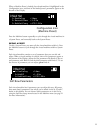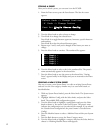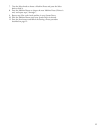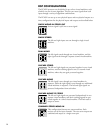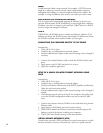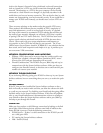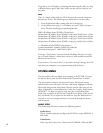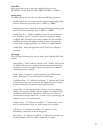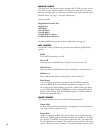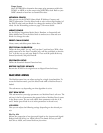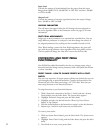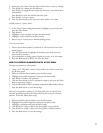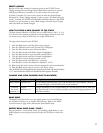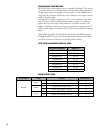19
Clock Rate
Select your clock rate here, when the wordclock source is set to
INTERNAL. Choose from 44.1HKz, 48KHz, 88.2KHz, or 96KHz.
Analog Setup
The Analog Setup sub-menu lets you adjust the following parameters:
Analog Input Level - Increases or decreases the incoming analog signal
before it reaches the processor(s). Set to +4dBU or –10dBU.
Analog Output Level - Increases or decreases the outgoing analog signal
after it leaves the processor(s). Set to +4dBU or –10dBU.
Analog Type IV
TM
- Enable or disable the Type IV conversion system
here. The dbx
®
Type IV Conversion System is a proprietary analog-
to-digital (A/D) conversion process that combines the best attributes
of digital conversion and analog recording processes to preserve the
essence of the analog signal when it is converted to a digital format.
Global Mute - Mutes all signals from the PCM92. Set to Muted or
Unmuted.
AES Setup
The AES Setup sub-menu gives you the status of the following AES infor-
mation:
Data Validity - “Valid” indicates the data is OK. “Invalid” indicates that
the Validity bit was set in a frame of incoming data and that the data
attached to it may be corrupted. This bit may also be sent when the
transmitting device is paused.
Mode - Select “Consumer” to send information in S/PDIF format.
Select “Professional” to send information in AES format.
Confidence Error - “0” indicates no problem. “1” indicates the PCM92
is detecting excessive jitter or noise on the digital audio line. No data
has been corrupted, but corrective action should be taken.
Sample Slip - An unchanging number indicates you are not slipping
samples. An increasing number indicates samples are misaligned with
the window defined by the Input Source. This may occur when an
external master changes sample rate, or when it is just powering up, but
should not occur in normal operation.
Bi-Phase Error - “0” indicates no problem. “1” indicates that at least
one bit (and therefore at least one audio sample) was corrupted.
CRC Error - “0” indicates no problem. “1” indicates a Cyclic
Redundancy Check error in the incoming data.
Parity Error - “0” indicates no problem. “1” indicates that at least one
bit (and therefore at least one audio sample) was corrupted.



